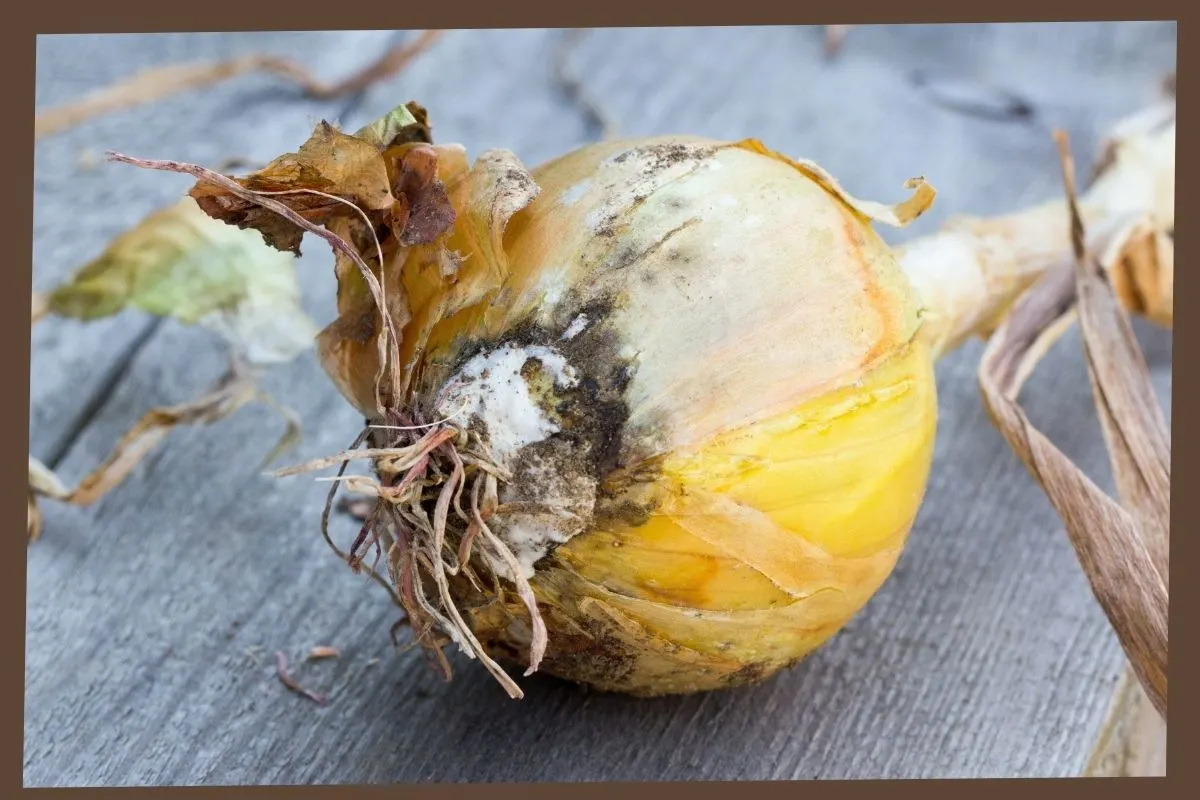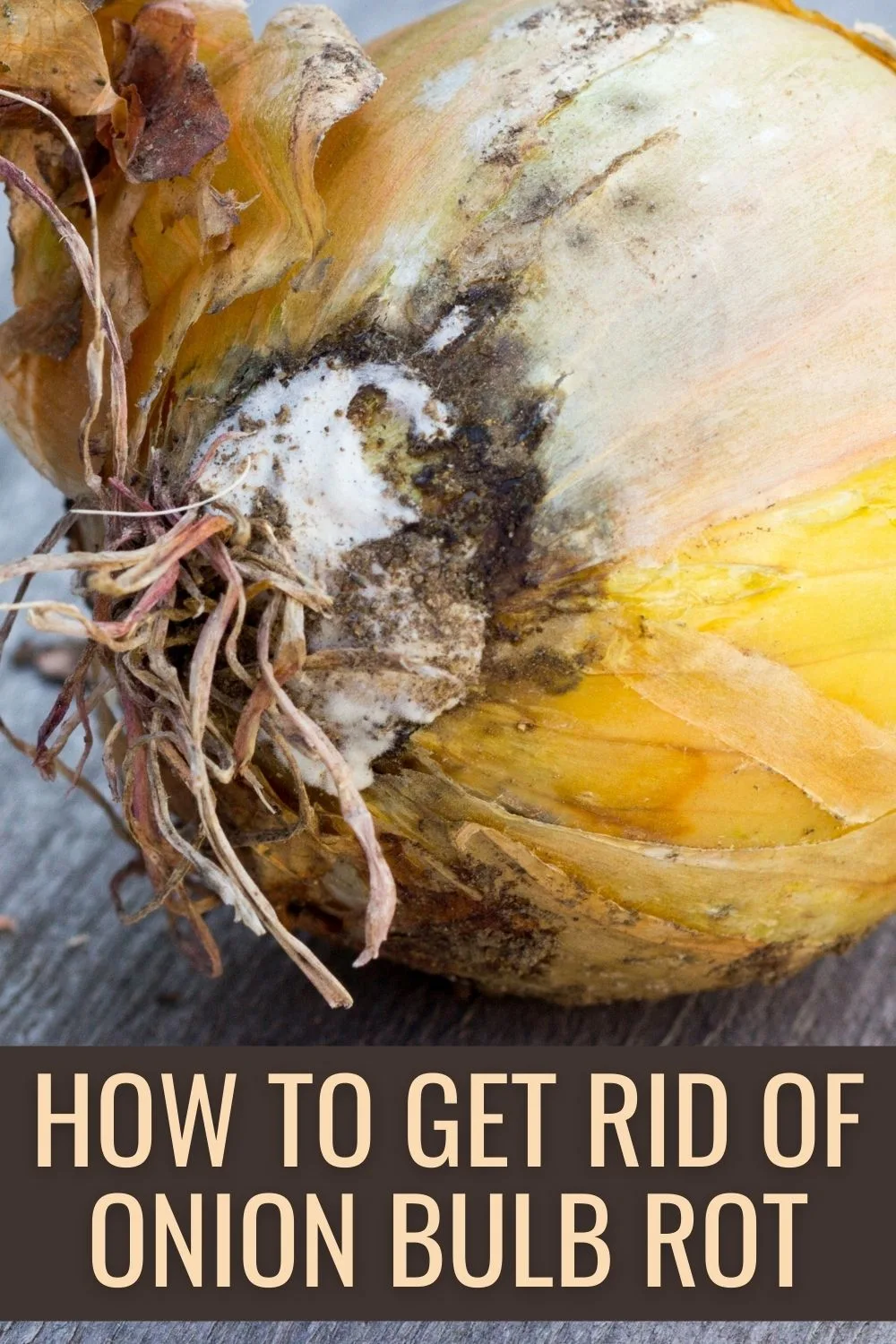I love growing root crops. The foliage only provides hints at what is happening in the soil as you tend to the plants throughout the season, leaving the harvest a surprise. I have laughed out loud in the garden upon unearthing a sweet potato the size of my face. Of course, this can lead to unpleasant surprises, too, like mushy onion bulbs. If you’ve dug up a disappointing onion crop or sense that something might be amiss in your onion patch, you’ll want to take a look at how to get rid of onion bulb rot and how to prevent it from happening in the future.

Symptoms Of Onion Bulb Rot
There are actually many types of onion bulb rot, some of which occur during storage (such as the last two in the list below), though most begin while the plants are still in the soil:
- basal plate rot
- pythium rot
- slippery skin
- soft rot
- sour skin
- white rot
- botrytis
- mush rot
While symptoms vary depending on the specific type of rot, they are all fairly similar. In the early stages, the leaves might wilt during the day and recover over night. Eventually, though, they can turn yellow or white and even die back.
Keep a close eye on the necks, or lower stems, of your onions, especially if the leaves begin showing symptoms of rot. Water-soaked lesions at the base of the stalk are a sure sign of several types of rot, and white rot, as the name suggests, appears as a fluffy white fungus.
Rot often progresses from the neck down, though it sometimes creeps up from the roots or, as with slippery skin, exhibits no external symptoms other than a softened neck and one or two collapsed leaves.
In advanced stages, most rots result in brown, mushy bulbs. Onions with slippery skin rot, dry out and shrivel. Botrytis rot, which occurs in storage, results in gray, translucent discoloration.
Causes Of Onion Bulb Rot
Most types of onion bulb rot are fungal diseases; the rest, including slippery skin, soft rot, and soft skin, are the result of bacterial infection.
Excess moisture during the growing season often encourages these diseases, all of which can overwinter in plant debris. Any damage to onion bulbs during harvest or by onion maggots can provide an entry point for bacteria.
How To Treat Onion Bulb Rot
Unfortunately, plants that show signs of onion bulb rot are often beyond saving. The best way to control onion bulb rot is through the preventative measures described in the next section. If you do have the misfortune of finding bulb rot among your onions, dig up (if they are still in the ground) and discard all affected bulbs, including any foliage and roots.
Next, kill the fungi or bacteria remaining in the soil by solarizing the soil in your onion patch. To do this, cover the area with clear plastic sheeting, burying or weighing down the edges to prevent it from blowing away. Leave the plastic down for four to six weeks, then roll it up and store it for future use. Avoid planting onions in the same place for at least three years; white rot can survive for up to 20!
You can, of course, opt to use an organic fungicide, but use it sparingly to prevent the fungi from developing a resistance to the fungicide.
How To Prevent Onion bulb Rot
As mentioned above, prevention is the best method for controlling onion bulb rot. Use the below practices to produce a healthy crop of onions and prevent onion bulb rot, whether you’ve had an infection in the past or not.
1. Choose resistant varieties
Especially if you have experienced onion bulb rot in the past, you will want to look for rot-resistant varieties when browsing seed catalogs. Different varieties will be resistant to different types of rot, so look for those that resist the disease you have had in your garden in the past, or ask gardening neighbors or your local extension office for recommendations of onions that grow well in your area.
2. Practice crop rotation
Crop rotation is always a good idea for preventing diseases and pests that overwinter in the soil. For most types of onion bulb rot, you will want to aim for a three- to five-year rotation of alliums. Corn can increase populations of the bacteria that cause sour skin, so you may want to keep that in mind if you have had problems with it in the past.
3. Plant in well-draining soil
Plant your onions in well-draining soil to help prevent them from getting too soggy during the growing season. If your area gets a lot of rain, consider using raised beds, even if that just means raking the soil up higher between the paths; raised beds don’t have to have frames if you don’t want them to!
4. Avoid overwatering
While water is important for bulb formation, too much can definitely be a bad thing. Avoid using sprinklers or other overhead irrigation, and instead aim water at the base of the plants with drip tape, soaker hoses, or a handheld sprayer. Water deeply and regularly, but less often, allowing the soil to dry out between waterings.
5. Weed regularly
The fungi and bacteria that cause onion bulb rot can overwinter in weed roots and plant debris. Therefore, it’s important to pull weeds frequently and clean up any debris in and around the onion bed.
6. Harvest gently
Because any damage to onion bulbs can provide an opening for rot-causing bacteria, always handle onions with care. Place the digging fork tines vertically in the soil several inches from the bulbs to avoid stabbing them, then gently pull the onions out of the loosened soil and place them in your harvest container to prevent bruising. Care should also be taken when weeding and cultivating.
7. Cure thoroughly
First, make sure the tops of the onions are fully mature and dry before digging up the bulbs. After harvest, immediately set the onions to cure in a well-ventilated space, and allow them to cure thoroughly for at least two to three weeks before putting them in storage (learn more about storing root vegetables). To prevent botrytis rot in storage, carefully cut off all roots and leaves.
8. Store properly
Onions should be stored in a ventilated container, such as a wire basket, shallow plastic crate, or mesh bag, at 32 to 40 F and 65 to 70 percent humidity. If properly cured and stored, most onions will last for about three months.
Onion bulb rot can be devastating, but there are many measures you can take to prevent it from infecting your crop. Above all, keep the garden tidy, practice crop rotation, and avoid excess moisture at all stages. And, of course, enjoy the harvest!
How To Get Rid Of Onion Bulb Rot
As you probably figure out by now, if your onions are affected, there’s no way to get rid of the onion bulb rot. But you can take measures for next year’s crop, by working on preventing this nasty disease (see the 8 tips above).

Serena Manickam is a freelance editor and writer and sustainable market gardener in rural Virginia. She holds a BA in environmental science and runs Fairydiddle Farm, a small market garden in which she grows no-spray produce and herbs to sell at a local farmer’s market.


How To Grow Allium Vegetables
Thursday 7th of October 2021
[…] Although these are different diseases, they are often evident with the same symptoms. Learn more about how to prevent onion bulb rot. […]